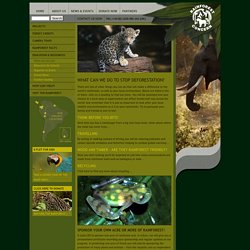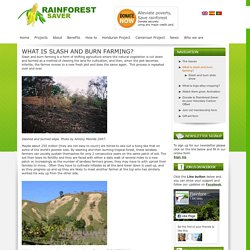

Deforestation Facts, Deforestation Information, Effects of Deforestation. Modern-Day Plague Deforestation is clearing Earth's forests on a massive scale, often resulting in damage to the quality of the land.

Forests still cover about 30 percent of the world’s land area, but swaths the size of Panama are lost each and every year. The world’s rain forests could completely vanish in a hundred years at the current rate of deforestation. Forests are cut down for many reasons, but most of them are related to money or to people’s need to provide for their families.The biggest driver of deforestation is agriculture.
Farmers cut forests to provide more room for planting crops or grazing livestock. Logging operations, which provide the world’s wood and paper products, also cut countless trees each year. Not all deforestation is intentional. Deforestation has many negative effects on the environment. Deforestation also drives climate change. Trees also play a critical role in absorbing the greenhouse gases that fuel global warming. Rainforest Concern - What can we do to stop deforestation?
There are lots of other things you can do that will make a difference to the world’s rainforests, as well as your local environment.

Below are listed a few of them: click on a heading to find out more. You will be surprised how your choices in a local shop or supermarket can affect forests half way across the world! And remember that it is just as important to look after your local wildlife and environment as it is to save rainforests. Try to persuade your family and friends to join in too!
Next time you buy a hamburger from a big fast food chain, think about where the meat has come from... Travelling By cycling or walking instead of driving you will be reducing pollution and carbon dioxide emissions and therefore helping to combat global warming... Wood and timber - are they rainforest friendly? Once you start looking you'll be surprised at just how many wood products are made from rainforest trees such as mahogany or teak... Recycling Click here to find out more about recycling... What is slash and burn farming? Slash and burn farming is a form of shifting agriculture where the natural vegetation is cut down and burned as a method of clearing the land for cultivation, and then, when the plot becomes infertile, the farmer moves to a new fresh plot and does the same again.

This process is repeated over and over. Slashed and burned slope. Photo by Antony Melville 2007. Maybe about 250 million (they are not easy to count) are forced to eke out a living like that on some of the world's poorest soils. By slashing and then burning tropical forest, these landless farmers can usually sustain themselves for only 2 consecutive years on the same patch of soil.
Hillsides denuded by continuous slash and burn. When the plots are far from the dwelling place cash crops cannot be guarded from thieves or wild animals, nor can the family help when there are young children. In earlier times when the population density was less, slash and burn worked reasonably well. Deforestation Intro - Revolution. Discover the threats, causes and impacts, and how you can help.

The Lungs of Our Earth in Jeopardy Inspired from the movie Revolution and narrated by Rob Stewart, our Educational Video gives you more content on Deforestation. Trees are a vital organ of our planet and our survival. Our forests control climate, cycle water, protect soil, store carbon, supply medicine and most importantly produce more than 40 percent of the world’s oxygen. Currently, trees cover approximately 31 percent of the earth. Deforestation, the loss of forests around the world, is occurring at an astounding rate of one football field per second. Forests are the lungs of the earth Tree evolution has changed little in the last 70 million years.
The more trees we lose, the less oxygen we have to breathe. Learn more about our beautiful forests and the devastation deforestation is causing by reading on and sharing this information with everyone you know. Deforestation Facts, Deforestation Information, Effects of Deforestation. Wildfires Article, Forest Fires Information, Wildland Fires Facts. Uncontrolled blazes fueled by weather, wind, and dry underbrush, wildfires can burn acres of land—and consume everything in their paths—in mere minutes.

On average, more than 100,000 wildfires, also called wildland fires or forest fires, clear 4 million to 5 million acres (1.6 million to 2 million hectares) of land in the U.S. every year. In recent years, wildfires have burned up to 9 million acres (3.6 million hectares) of land. A wildfire moves at speeds of up to 14 miles an hour (23 kilometers an hour), consuming everything—trees, brush, homes, even humans—in its path. Deforestation. Forests cover 31% of the land area on our planet.

They produce vital oxygen and provide homes for people and wildlife. Many of the world’s most threatened and endangered animals live in forests, and 1.6 billion people rely on benefits forests offer, including food, fresh water, clothing, traditional medicine and shelter. But forests around the world are under threat from deforestation, jeopardizing these benefits. Deforestation comes in many forms, including fires, clear-cutting for agriculture, ranching and development, unsustainable logging for timber, and degradation due to climate change. This impacts people’s livelihoods and threatens a wide range of plant and animal species. Forests play a critical role in mitigating climate change because they act as a carbon sink—soaking up carbon dioxide that would otherwise be free in the atmosphere and contribute to ongoing changes in climate patterns.
WWF has been working to protect forests for more than 50 years.